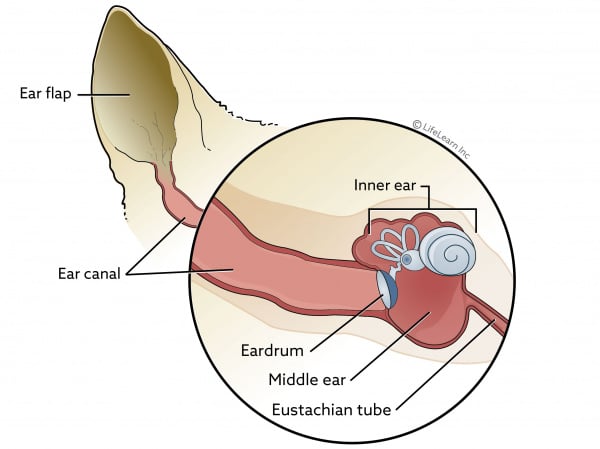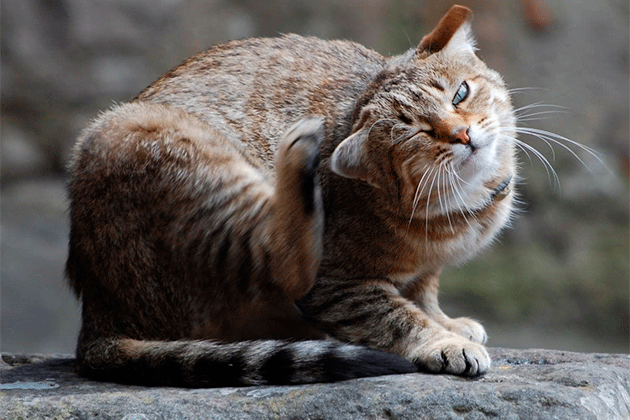
Отитис медиа код мачака и паса

Otitis media is one of the most common ear infections in cats and dogs. Consider the causes of its occurrence and methods of treatment.
Otitis media is an inflammation of the ear in dogs, cats, other animal species, and humans.
It can be external (affects the ear from the auricle to the eardrum), middle (department behind the eardrum) and internal (inner ear), in some cases, otitis media can occur with damage to different parts of the ear at the same time.
- Acute otitis: quite severe pain, sudden and rapid development of symptoms.
- Chronic otitis media: Has an insidious symptomatology, with a long course of the disease with alternating periods of exacerbation and remission.
Узроци појаве
Several factors are usually involved in the occurrence of otitis media.
Main causes and predisposing factors:
- Allergies, such as atopy or food hypersensitivity
- Ear mites (otodectosis)
- Foreign bodies (eg, grass seeds, sand and small stones, insects)
- Neoplasms in the ear canal and on the auricle
- Ear shape. The ear canal of dogs and cats is deep and curved. This means that dirt, sulfur and moisture can easily accumulate. Some breeds are more susceptible than others. In spaniels, setters, bassets, sharpeis, poodles, St. Bernards, Scottish Fold cats and other breeds of dogs and cats with long hanging, pressed against the head, the auricle closes the opening of the canal. In addition to the shape of the ear, an excessive amount of hair inside the ear can create a predisposition to otitis, for example, in Persian cats, collies, spitz-shaped dogs. This restricts airflow and traps moisture, creating the perfect environment for inflammation to develop. At the same time, dogs with erect large ears, but short hair, can also suffer from otitis media if the ear is blown too well (for example, Thai Ridgebacks, Bull Terriers, docked Dobermans).
- Climate with high humidity, high or too low air temperature
- Water in the ears: inaccurate washing, dog diving into ponds or snowdrifts with his head, wallowing in puddles and mud
- Excessive formation of sulfur in the ear canals with inappropriate nutrition for the pet, as well as with too diligent, frequent and improper cleaning of the ears
Often a secondary bacterial or fungal infection joins, which greatly exacerbates the problem. Unfortunately, some dogs and cats that are predisposed to otitis media can be difficult to cure completely and often relapse. Understanding the cause can help treat and prevent the condition.
simptomi
Dogs and cats with otitis media may show any or all of the following:
- Itching around the ears, shaking or shaking the head, trying to rub against furniture or the floor
- Red or dark, hot, inflamed, and swollen skin inside the ear
- The appearance of scales, crusts, sores on the inner surface of the auricle
- Sore ears, the pet does not allow to touch them
- Непријатан мирис
- Исцједак из уха
- Horner’s syndrome – with nerve damage, a neurological disorder can be observed, manifested by omission of the eyelid, prolapse of the third eyelid, pupil constriction, and enophthalmos (deeper than normal position of the eye in the orbit).
- Vestibular disorders: ataxia, unsteady gait, difficulty with orientation in space
- Tilt of the head towards the affected ear, unnatural position of the head
- Aggression or lethargy
Otitis media can be long-lasting, very painful and distressing, and does not go away on its own.
Left untreated, this can lead to serious problems ranging from infection of the middle and inner ear, damage to the eardrum, deafness, clawing of the auricle and muzzle around the ear, neck, cheek from scratching, entry and development of secondary infections, to damage to the vital organs of the head ( the inner ear is located deep, and the brain and nerves are close), sepsis and even death.
Лечење
Before starting treatment, it is necessary to determine what type of otitis media your pet has and treatment will vary based on clinical findings.
Otitis externa is usually treated by instilling drops or ointment directly into the affected ear. The preparations will contain one or more of the following ingredients, depending on the results of the tests:
- Antibiotics – against bacterial infection
- Antimycotics – antifungal
- Acaricides – to get rid of ear mites
- Anti-inflammatory – to reduce pain/swelling
- Antiseptics – for the treatment of the auricle
In addition to ear drops, your doctor will usually recommend using a cleansing hygienic solution to remove excess wax, dirt, and pus from your ear canal. Without proper sanitation, ear drops often fail to penetrate the canal and do their job.
In some complicated cases, dogs undergo a total resection of the auditory canal.
If you scratch your pet’s ears too actively, it is worth putting on a protective collar to avoid injury to the auricle and infection.
In no case should you engage in self-treatment of the ears, without knowing the exact cause that caused otitis media, examination and tests by a veterinarian will allow you to treat your pet’s ears more quickly and efficiently.
Превенција
For the prevention of ear diseases it is necessary:
- Check your pet’s ears regularly
- If necessary, remove excess hair (this hygienic procedure is carried out by a professional groomer)
- If necessary, clean the ears with a hygienic lotion and a cotton swab, or a cotton pad folded 2-4 times. In no case should you clean your ears with cotton swabs and rinse with water.
- When washing pets, do not wet the head and make sure that water does not get into the ears.
- Dogs with a predisposition to otitis during walks in slushy, frosty or rainy weather can wear caps made of breathable material, such as membrane fabrics with or without lining.





